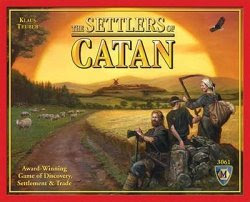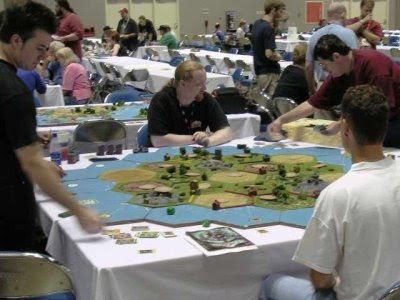Settlers of Catan
 Settlers of Catan is a multiplayer board game designed by Klaus Teuber (pronounced: Toy-Ber). It was first published in 1995 in Germany by Franckh-Kosmos Verlags-GmbH & Co. (Kosmos) under the name Die Siedler von Catan.
Settlers of Catan is a multiplayer board game designed by Klaus Teuber (pronounced: Toy-Ber). It was first published in 1995 in Germany by Franckh-Kosmos Verlags-GmbH & Co. (Kosmos) under the name Die Siedler von Catan.
Settlers was the first German-style board game to achieve popularity outside Europe, and has been called the "killer app" of designer board games. Over 15 million games in the Catan series have been sold, and the game has been translated into thirty languages from the original German. The game has rapidly become popular in part because its mechanics are relatively simple, while its dynamics are quite complex. The game is well suited for family play, since no one gets eliminated, and players who are behind can strive towards goals that are within their reach.
The standard game and its many expansions are available from Mayfair Games in the United States and United Kingdom, from Capcom in Japan, Kosmos and 999 Games in the European Union, Κάισσα in Greece (Οι άποικοι του Κατάν), Devir in Spain, Portugal and Latin America, and Strategy Games in Canada.
Gameplay
The players in the game represent the eponymous settlers, establishing a colony on the previously uninhabited island of Catan. The island itself is composed of hexagonal tiles ("hexes") of different land types which are laid out randomly at the beginning of each game. Numbered tokens are then placed on each of the tiles, except for one desert hex.

Starting with two settlements and adjoining road sections, players build roads, settlements, and eventually cities as they settle the island. Roads are built along the edges of the hexes, and settlements at the corners; no two settlements may be built on adjacent corners. Positioning of roads and settlements allows a player to deny other players access to essential resources, and good building is one route to victory.
Each turn, a roll of the two dice determines which hexes produce resources. Production of resources (clay, lumber, wool, grain, and ore) is the main random element in the game. Normally, players with settlements adjacent to those hexes receive resource cards of the appropriate type, with cities yielding more resources. However, if the dice roll is 7, the "robber" token must be moved to a different hex. This allows the player to prevent that hex from producing resources and to steal a resource card from another player.
The resource cards can be spent to build more roads or settlements, upgrade settlements to cities, and to obtain development cards for later use; or they can be stored for trade or later use. When a seven is rolled, players with eight or more stored resources lose half their stored resources, making the choice of whether to build or store resources a difficult one.
 Settlers of Catan is a multiplayer board game designed by Klaus Teuber (pronounced: Toy-Ber). It was first published in 1995 in Germany by Franckh-Kosmos Verlags-GmbH & Co. (Kosmos) under the name Die Siedler von Catan.
Settlers of Catan is a multiplayer board game designed by Klaus Teuber (pronounced: Toy-Ber). It was first published in 1995 in Germany by Franckh-Kosmos Verlags-GmbH & Co. (Kosmos) under the name Die Siedler von Catan.Settlers was the first German-style board game to achieve popularity outside Europe, and has been called the "killer app" of designer board games. Over 15 million games in the Catan series have been sold, and the game has been translated into thirty languages from the original German. The game has rapidly become popular in part because its mechanics are relatively simple, while its dynamics are quite complex. The game is well suited for family play, since no one gets eliminated, and players who are behind can strive towards goals that are within their reach.
The standard game and its many expansions are available from Mayfair Games in the United States and United Kingdom, from Capcom in Japan, Kosmos and 999 Games in the European Union, Κάισσα in Greece (Οι άποικοι του Κατάν), Devir in Spain, Portugal and Latin America, and Strategy Games in Canada.
Gameplay
The players in the game represent the eponymous settlers, establishing a colony on the previously uninhabited island of Catan. The island itself is composed of hexagonal tiles ("hexes") of different land types which are laid out randomly at the beginning of each game. Numbered tokens are then placed on each of the tiles, except for one desert hex.

Starting with two settlements and adjoining road sections, players build roads, settlements, and eventually cities as they settle the island. Roads are built along the edges of the hexes, and settlements at the corners; no two settlements may be built on adjacent corners. Positioning of roads and settlements allows a player to deny other players access to essential resources, and good building is one route to victory.
Each turn, a roll of the two dice determines which hexes produce resources. Production of resources (clay, lumber, wool, grain, and ore) is the main random element in the game. Normally, players with settlements adjacent to those hexes receive resource cards of the appropriate type, with cities yielding more resources. However, if the dice roll is 7, the "robber" token must be moved to a different hex. This allows the player to prevent that hex from producing resources and to steal a resource card from another player.
The resource cards can be spent to build more roads or settlements, upgrade settlements to cities, and to obtain development cards for later use; or they can be stored for trade or later use. When a seven is rolled, players with eight or more stored resources lose half their stored resources, making the choice of whether to build or store resources a difficult one.
Players are allowed to trade among each other the resources they have produced, and to trade "off the island" for a hefty price. By building settlements in certain positions, players may obtain better off-island trading prices. Bad luck in the game can be mitigated by trading, and trading is the main method of player interaction in the game; astute trading is another route to victory.[3] If a player is winning, other players may refuse to trade with him or her; this allows them to catch up with the leader.
A player receives a victory point for each settlement built, and another for each settlement upgraded to a city. Various other achievements, such as establishing the longest road or building the largest army, grant a player additional victory points. The victor is the first player to possess ten victory points on his or her turn.
There is no combat. Players may harm each other by moving the robber, refusing to trade, cutting off building routes, taking the "longest road" and "largest army" cards, and using certain development cards. The layout of the board and restrictions on building allow for a player to be boxed in through poor play or bad luck. Also, given the random component of the board layout, it is possible for a player to gain a monopoly on a certain resource, then demand steep trade rates from the other players. Home games generally take between one and two hours to complete.
Teuber's original design was for a large game of exploration and development in a new land.[5] Between 1993 and 1995 Teuber and Kosmos refined and simplified the game into its current form. Unused mechanics from that design went on to be used in Teuber's following games, Entdecker and Löwenherz. The game's first expansion, Seafarers of Catan, adds the concept of exploration, and the combined game (sometimes known as "New Shores") is probably the closest game to Teuber's original intentions.
--more--
A player receives a victory point for each settlement built, and another for each settlement upgraded to a city. Various other achievements, such as establishing the longest road or building the largest army, grant a player additional victory points. The victor is the first player to possess ten victory points on his or her turn.
There is no combat. Players may harm each other by moving the robber, refusing to trade, cutting off building routes, taking the "longest road" and "largest army" cards, and using certain development cards. The layout of the board and restrictions on building allow for a player to be boxed in through poor play or bad luck. Also, given the random component of the board layout, it is possible for a player to gain a monopoly on a certain resource, then demand steep trade rates from the other players. Home games generally take between one and two hours to complete.
Teuber's original design was for a large game of exploration and development in a new land.[5] Between 1993 and 1995 Teuber and Kosmos refined and simplified the game into its current form. Unused mechanics from that design went on to be used in Teuber's following games, Entdecker and Löwenherz. The game's first expansion, Seafarers of Catan, adds the concept of exploration, and the combined game (sometimes known as "New Shores") is probably the closest game to Teuber's original intentions.
--more--
*Wikipedia

No comments:
Post a Comment